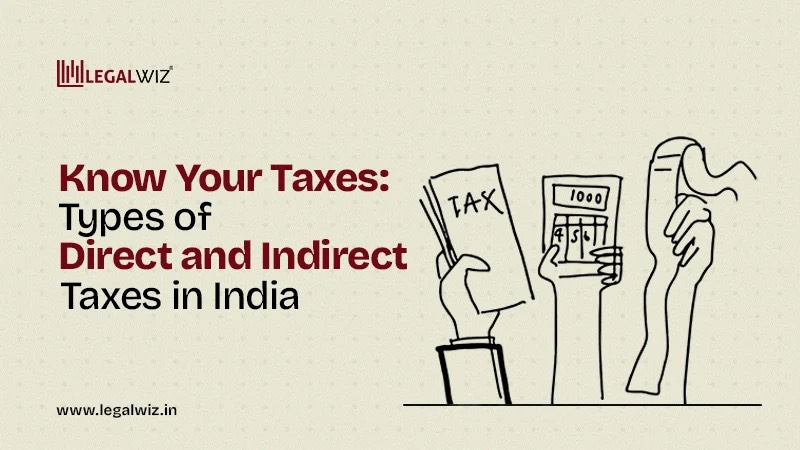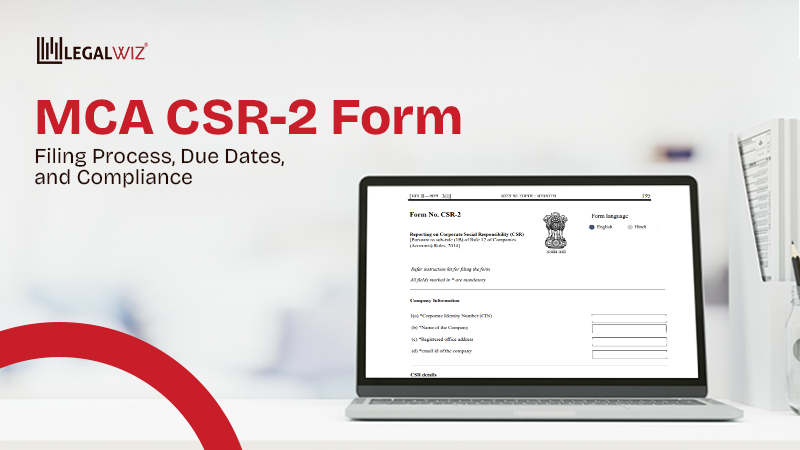Know Your Taxes: Types of Direct and Indirect Taxes in India
“Adulting is hard. Taxes make it harder — unless you understand them.”
From the moment your salary hits your account to the time you buy a coffee, taxes are quietly tagging along. Whether it’s that TDS deduction you didn’t expect or the surprise “GST extra” on your Swiggy order, taxes are everywhere.
But here’s the good news: taxes don’t have to be terrifying. With the right guidance, filing your ITR can actually be simple, stress-free, and maybe even satisfying (yes, really!).
This blog breaks down the two main categories of taxes in India — Direct and Indirect. We’ll keep it simple, relatable, and peppered with real-life examples (no legal jargon, promise!). So the next time someone says “CGST” or “capital gains,” you won’t just nod, you’ll actually know what they’re talking about.
And if you want to master the tax jargon (without Googling every second word), let us walk you through 5 important income tax terms you need to know. It’s your mini tax dictionary, minus the boring bits.
Let’s decode the world of Indian taxes, one pizza slice and payslip at a time.
Key Takeaways
– Taxes in India are either Direct (on income/profit) or Indirect (on spending).
– Income Tax, Capital Gains, and Corporate Tax are common Direct Taxes.
– GST, Customs, and Stamp Duty are common Indirect Taxes.
– Even if you don’t file ITR, taxes impact almost every transaction you make.
– Understanding taxes helps you save smarter and avoid nasty surprises.
Section 1: What Are Taxes & Why Do We Pay Them?
Let’s keep it simple: Taxes are the money you pay the government so the country keeps running, and doesn’t fall apart like a Jenga tower. From roads to ration cards, it all adds up.
And when it comes to taxes like TDS (Tax Deducted at Source), even the paperwork matters. Here’s a quick look at the documents required to file TDS online, so you’re not scrambling last minute.
Think of it as a compulsory contribution (yes, no opt-out button!) that helps fund public services you use every day, even if you don’t notice them.
Who Collects Taxes in India?
India’s tax system is a team effort:
- Central Government: Handles income tax, customs duty, excise, and CGST.
- State Governments: Collect SGST, state excise (like on alcohol), and stamp duties
- Local Bodies: Property tax, water tax, garbage collection fees (your municipality’s mini invoice).
Where Does Your Tax Money Go?
Here’s where your hard-earned rupees get redirected:
- Roads and Highways: From potholes to expressways
- Railways and Metro Projects: Daily commute fuelled by taxes
- Education & Healthcare: Government schools, AIIMS, vaccination drives
- Digital India & Infrastructure: From UPI to Smart Cities
- Defence & National Security: Because memes can’t protect borders
So yeah, taxes may feel like a pinch, but without them, the lights go out — literally and figuratively. And filing your ITR is just as crucial. Here’syour beginner-friendly guide to the ITR filing fundamentals, so you can file smart, avoid penalties, and stay stress-free.
Section 2: The Two Pillars – Direct vs Indirect Taxes
Let’s get this straight: every rupee you earn or spend is probably taxed in some form. But not all taxes are created equal; some are upfront and personal, while others sneak in when you’re just trying to order a pizza.
Welcome to the world of Direct and Indirect taxes, the two mighty pillars holding up India’s tax system.
Truth bomb: “Direct hits your paycheck. Indirect hides in your pizza bill.”
What’s the Difference?
Direct Taxes: These are the “no sugar-coating” taxes. If you’re earning, investing, or profiting, you’re paying these. Think salary deductions, tax on your crypto gains, or even profits from stock trading.
Indirect Taxes: These are the “invisible extras.” They’re baked into the MRP of that ₹199 shampoo or the ₹500 movie ticket. You pay them without even realizing it, thanks to GST.
And if you’re a small business collecting GST? You’ve got filing responsibilities too. Don’t worry, here’s your simplified guide to GST quarterly return filing, because taxes shouldn’t get in the way of your hustle.
Here’s a simple breakdown:
| Feature | Direct Tax | Indirect Tax |
| Paid by | You (directly to the government) | You (indirectly through a seller) |
| Burden on | Income or profits | Goods and services |
| Visibility | Transparent (you see the deduction) | Hidden in prices (you barely notice) |
| Examples | Income Tax, Corporate Tax, Capital Gains | GST, Customs Duty, Excise, Stamp Duty |
Why It Matters:
Knowing which is which helps you:
- Understand where your money’s going
- Plan taxes smarter (especially if you’re self-employed or investing)
- Do not fall for the “GST extra? What’s that?” confusion at stores or online checkouts
In short, the more you know, the less likely you’ll be taxed and confused.
And if you’re still a bit confused about the difference?
Here’s a handy cheat sheet that breaks down Direct and Indirect Taxes side by side. Bookmark this table, because it’s the kind of thing even your CA friend refers to!
Direct Tax vs Indirect Tax: A Quick Comparison
| Feature | Direct Tax | Indirect Tax |
| Definition | Tax paid directly to the government by the individual/entity | Tax collected by sellers on goods/services and passed to the government |
| Who Pays | You (individuals, companies, firms) | You (as a consumer), but via a third party (seller/vendor) |
| Based On | Income, profit, gains | Spending, consumption, purchases |
| Visibility | Transparent (you see it on your salary slip or filings) | Hidden in the price (MRP includes it, or is added at checkout) |
| Examples | Income Tax, Capital Gains Tax, Corporate Tax, STT | GST, Customs Duty, Excise, Stamp Duty, Entertainment Tax |
| Collected By | Government directly | Intermediary (retailers, service providers, importers) |
| Can You Avoid It? | Hard to avoid (tracked via PAN, salary, filings) | Mostly unavoidable (built into goods/services pricing) |
| Tax Planning Possible? | Yes (via deductions, exemptions, regimes) | Not really (rates fixed per category of goods/services) |
Section 3: Types of Direct Taxes in India
Direct taxes are basically the government’s way of saying, “Congrats on earning money! Now share some.” These taxes are paid directly by individuals, businesses, or investors to the government, with no middlemen involved.
And yes, even that side hustle or crypto flip counts.
If you made money selling crypto or your grandma’s gold, the taxman is definitely interested.
Before we take a deep dive, let’s just glimpse what is ahead on the road –
Quick Glimpse: Common Direct Taxes in India:
| Tax Type | Who Pays | What’s Being Taxed | Need to Know |
| Income Tax | Salaried, freelancers, and businesses | Your annual income | Slab-based. Choose between the Old vs New regime. TDS applies. |
| Corporate Tax | Domestic & foreign companies | Company profits | ~22% for most. 15% for new manufacturing units (conditions apply). |
| Capital Gains Tax | Investors, property sellers | Profit from assets (stocks, real estate, gold) | Short vs Long-term gains. LTCG on equity over ₹1L taxed @10%. |
| STT (Securities Transaction Tax) | Stock market traders/investors | Every buy/sell on stock exchanges | Auto-deducted. Varies by trade type. Sneaky but small! |
| Wealth Tax (Defunct) | Super-rich (pre-2015) | Net wealth (property, gold, luxury items) | It’s scrapped for most people. Now replaced by a surcharge on the ultra-rich. |
Here’s a breakdown of the most common direct taxes you might be (or soon will be) paying:
Income Tax
This one’s the classic.
If you earn a salary, run a business, or freelance, you’re in this club.
- Tax is based on income slabs (which change almost every year)
- Applies to individuals, HUFs, partnership firms, and more
- TDS (Tax Deducted at Source) is how the taxman gets paid before you even see the full amount
Pro Tip: Choosing the right regime (Old vs New) matters. One gives you deductions, the other gives you simplicity.
Corporate Tax
This one’s for the big players.
Companies — whether domestic or foreign- are taxed on the profits they make in India.
- Domestic companies: ~22% base tax (plus surcharge & cess)
- New manufacturing companies: Just 15% (under certain conditions)
But don’t worry, unless you’re running a company, this one’s not your headache.
Capital Gains Tax
Sold shares, mutual funds, land, or that second flat in Goa? There’s a tax for that.
- Short vs Long Term: Tax rate changes based on how long you held the asset.
- Different assets, different rates: Property, stocks, gold; each has its own tax rule.
- LTCG (Long-term capital gains) on equity: Gains over ₹1L from shares are taxed at 10%, no inflation adjustment.
Think of it as “a tax on the profit you made by selling stuff that grew in value.”
Securities Transaction Tax (STT)
For all you stock market warriors, here’s the silent tax ninja.
- Charged on every stock trade (buy/sell) through the stock exchange
- Rates vary for intraday, delivery, futures, and options
- You don’t pay it manually, your broker does, and it’s built into your trading costs
STT is small per trade, but it adds up, especially for active traders.
Wealth Tax (Throwback Alert!)
This used to be charged on your net wealth, property, gold, fancy cars, etc.
But it was scrapped in 2015.
Now replaced with a surcharge on the super-rich, so unless you’re in Ambani territory, relax.
So next time someone says “direct taxes are too confusing”, you can casually drop terms like STT and LTCG — and walk away like a tax boss.
Section 4: Types of Indirect Taxes in India
Indirect taxes are like the background characters in a movie — always there, quietly doing their job, and taking a cut from your wallet without much noise.
Unlike direct taxes, you don’t pay these straight to the government. Instead, they’re collected via the goods and services you consume. From your Zomato order to your Netflix binge, it’s all being taxed.
This table is your tax teaser. Scan it now, and the rest will make a lot more sense!
Quick Glimpse: Common Indirect Taxes in India
| Tax Type | What’s Being Taxed | Who Collects It | Need to Know |
| GST (Goods & Services Tax) | Goods & services (almost everything!) | Centre & States (CGST + SGST/IGST) | Unified tax. Local = CGST+SGST, Interstate = IGST. Books = 0%, Chocolates = 18%! |
| Customs Duty | Imported (and some exported) goods | Central Government | iPhones from abroad? Customs is ready to greet you at the airport. |
| Excise Duty | Alcohol, fuel, tobacco (non-GST items) | Central Government | Charged at manufacture. Still alive and taxing where GST doesn’t go. |
| Stamp Duty | Property transactions & legal documents | State Governments | Varies by state. Can go up to 7% — not included in your home loan! |
| Entertainment Tax | Gambling, racing, amusement parks (select states) | State Governments | Some “fun” still taxed outside GST — because thrill isn’t free. |
Now, let’s pull back the curtain. Here are the most common types of indirect taxes you’re probably paying without even realizing it.
GST (Goods and Services Tax) – India’s Tax Unifier
Introduced in 2017, GST replaced a whole jungle of indirect taxes like VAT, service tax, excise, etc. Now, it’s the one ring to rule them all. And if you’re starting a business and wondering how to get your GST number online, this guide breaks it down step by step — no confusion, no jargon.
- CGST (Central GST): Goes to the Centre
- SGST (State GST): Goes to the State
- IGST (Integrated GST): For interstate transactions and imports
Example: Order a laptop from a different state? That’s IGST. Buy one locally? CGST + SGST.
Fun fact: Books have 0% GST. Chocolate bars? 18%. Choose your addiction wisely.
GST simplified tax collection, but filing returns on time is still a must. Whether monthly or quarterly, GST return filing ensures you stay compliant and avoid last-minute stress.
Customs Duty – The “Import Ka Charge”
Brought something from abroad? Customs is waiting at the airport.
- Levied on goods imported (and some exported) from India
- Rates vary based on item type, electronics, luxury items, apparel, etc.
That iPhone you got from Dubai? You saved money on the sticker price, but customs is ready to even the score.
Excise Duty – The OG Tax That Never Left
While most excise duties were merged into GST, a few stayed behind like the last guests at a party.
- Still applies to alcohol, petroleum products, and tobacco
- Charged at the manufacturing stage, but passed on to consumers
Every time fuel prices rise, excise is part of that “invisible hand.”
Stamp Duty – The Surprise on Your Property Papers
Planning to buy a house, flat, or land? Stamp duty is your official welcome tax.
- Levied by the state government
- Varies from state to state (can go up to 7% of property value!)
- Applies to sale deeds, gift deeds, lease agreements, etc.
Pro tip: Budget this in — it’s not part of your home loan!
Entertainment Tax – Still Lurking in the Shadows
While most entertainment services (movies, OTT, events) are under GST now, some states still levy entertainment tax separately, especially on:
- Betting and gambling
- Amusement parks
- Horse racing events
So yes, even fun comes with a price tag.
In a Nutshell: If you’ve ever wondered why the final bill is higher than the price tag, it’s probably GST, customs, or one of their silent cousins doing the math.
Section 5: How They Affect You (Without You Realising It)
You may think you’re not “into taxes,” but trust us, taxes are very into you. Even if you’re not filing ITRs or decoding tax slabs, they’re quietly shaping your spending, saving, and sipping habits (yes, even that overpriced coffee).
Here’s how:
The Price Tag Lie: What You See ≠ What You Pay
Ever picked up a product thinking it’s ₹500 and walked out paying ₹590? That’s GST + Cess + Maybe Packaging Tax saying “hello”.
- Restaurants: Food cost ₹800, but with 5% GST? That’s ₹840.
- Electronics: MRPs often already include taxes, but you’re still footing the full tax-loaded bill.
Bottom line: Always read the fine print before your wallet takes the hit.
TDS – Tax Deductions That Happen While You Sleep
TDS (Tax Deducted at Source) is the government’s way of collecting direct tax upfront — before you even see your full income. And as part of tax compliance, anyone liable to deduct tax at source must also file a TDS return. The good news? You can do it hassle-free, fully online, and expertly handled.
- On salary: Your employer deducts it monthly
- On bank interest: Your bank deducts it once you cross ₹40,000 (₹50,000 for seniors)
- On freelance/contract payments: Clients deduct TDS before paying you
It’s like an automatic tax debit; no consent needed.
Why Should You Care? (Yes, Really.)
Because ignorance = lost money. Here’s how:
- You might be eligible for a refund, but never claim it
- You could be overpaying taxes by not using available deductions
- You may end up in a tax planning mess, especially if you have multiple incomes, missed declarations, or investments scattered everywhere
Understanding how taxes hit you means you can hit back, smartly, and legally.
So even if you’re not actively “doing taxes,” they’re definitely doing you. Time to take the driver’s seat, right?
Section 6: Fun (and Scary) Facts About Indian Taxes
Taxes in India aren’t just serious business — they’re also full of weird, wild, and eyebrow-raising facts. Here’s a mix of fun and “wait, what?!” moments to lighten (or tighten) your tax perspective:
India Has 25+ Types of Taxes
From Income Tax to Toll Tax, Swachh Bharat Cess to Krishi Kalyan Cess, India’s tax buffet is not short on variety.
Some are visible, most are in stealth mode. You’ve probably paid half of them without even knowing it.
Only ~6.5 Crore People Pay Direct Tax
That’s less than 5% of India’s population!
So while you’re diligently filing your ITR, just know you’re part of an elite (and slightly overburdened) club of taxpayers.
Translation: A very small number of people are carrying the tax torch for a very large country.
GST on Chocolates is 18%, But Books? 0%
Yes, if you buy a ₹100 chocolate bar, you pay ₹118. But pick up a ₹500 novel? No tax added.
Moral of the story: Binge-reading is better for both your brain and your bank account.
Bonus Trivia:
- Gold attracts 3% GST, but ice cream? That’s 18%.
- Petrol & diesel are still outside GST (yup, that’s why prices stay wild).
- You can’t escape taxes even after death; estate duties existed until 1985 (they might return someday).
Whether you find them funny or freaky, these facts prove one thing: taxes are everywhere, and they love surprises.
LegalWiz.in — Your Partner in Tax-Sanity
From accurate ITR filing to hassle-free GST registration and personalized tax planning, we make sure you’re never lost in legalese.
So, tax less. Save more. And leave the paperwork to us.
Talk to Our Tax Experts Today (We promise they speak fluent “non-jargon.”)
Still got questions? Drop them below or connect with us, and let’s decode your taxes together!
Final Thoughts: Tax Less. Plan Better.
Let’s face it, taxes aren’t going anywhere. But the confusion around them? That’s optional.
In this guide, we broke down the complex world of direct vs indirect taxes, looked at how they impact your income and expenses, and even uncovered some pretty wild tax facts (yes, chocolates really are taxed more than books).
The bottom line?
The more you understand your taxes, the better you can plan, save, and avoid surprises.
Whether you’re filing an ITR, registering for GST, or just trying to decode your payslip, being tax-smart is no longer just for CA students.
Frequently Asked Questions
What is the difference between direct tax and indirect tax in India?
Direct tax hits your income; you pay it yourself (like income tax). Indirect tax hides in your spending; you pay it via the seller (like GST). One’s upfront, the other’s sneakily built into prices.
Which are the most common direct taxes in India?
The usual suspects are Income Tax, Corporate Tax, Capital Gains Tax, and STT. These are paid directly by individuals or businesses based on income, profits, or gains, with no middlemen involved.
What are the different types of indirect taxes in India?
GST tops the list, followed by Customs Duty, Excise Duty, Stamp Duty, and Entertainment Tax. These taxes are added to goods and services; you pay them without realizing it, every time you shop or stream.
Is GST a direct tax or an indirect tax?
GST is an indirect tax. You don’t pay it directly to the government; it’s collected by sellers on everything from food to furniture, and quietly added to your final bill.
Do salaried employees pay indirect taxes too?
Absolutely! Even if your employer handles your income tax, you still pay GST, fuel tax, and more every time you eat out, shop online, or buy a movie ticket. No one’s tax-free.
What is TDS, and how does it affect my salary or income?
TDS (Tax Deducted at Source) is tax taken out before money hits your account, like on salary, bank interest, or freelance payments. It’s the government’s way of saying, “We’ll take our cut first!”
Are petrol and diesel under GST in India?
Nope! Petrol and diesel are still taxed separately through excise and VAT, which is why fuel prices don’t budge even when GST rates change. They’re officially outside the GST club (for now).
Can I reduce my direct tax liability legally?
Yes! Use deductions under sections like 80C, 80D, HRA, and more. You can also pick the right tax regime — old (with deductions) or new (simpler rates). Smart planning = more savings.
Why should I care about indirect taxes if they’re included in the price?
Because they directly affect what you pay! From your ₹120 coffee to that ₹50,000 phone, indirect taxes like GST and customs duty inflate your final bill. Knowing them helps you spend smarter.
Where can I get help with tax filing and planning in India?
Easy – just head to LegalWiz.in. From ITR filing to GST help, their experts decode taxes in plain English (not legalese) and help you file stress-free, without burning a hole in your wallet.

Sapna Mane
Sapna Mane is a skilled content writer at LegalWiz.in with years of cross-industry experience and a flair for turning legal, tax, and compliance chaos into clear, scroll-stopping content. She makes sense of India’s ever-changing rules—so you don’t have to Google everything twice.







